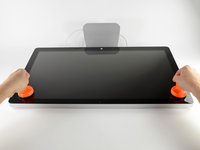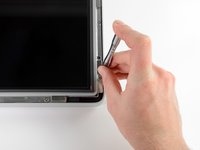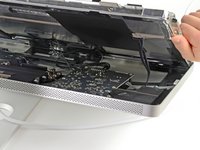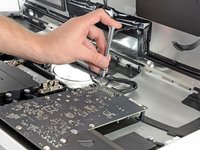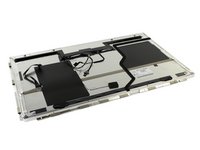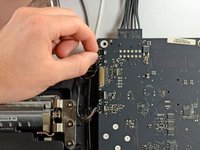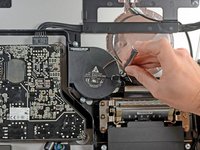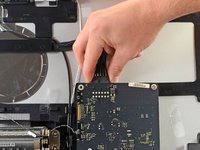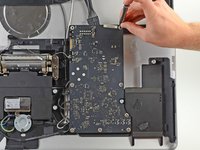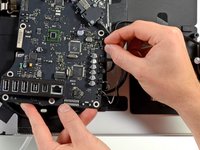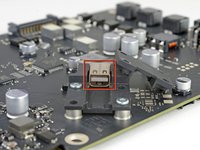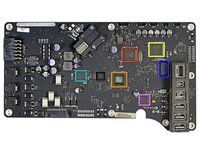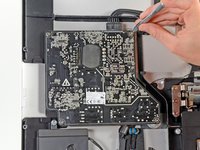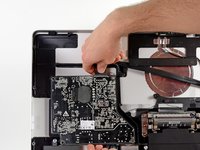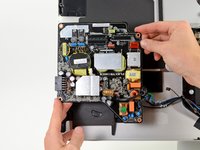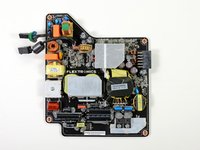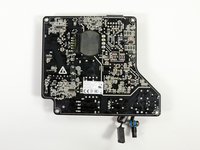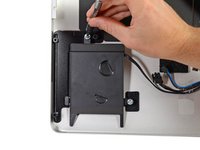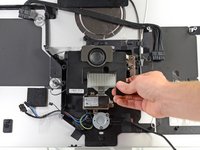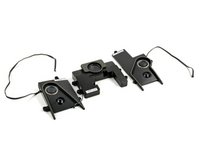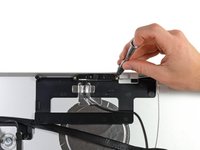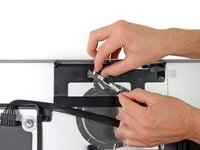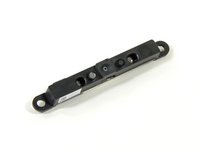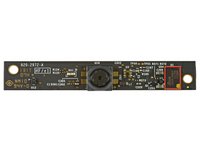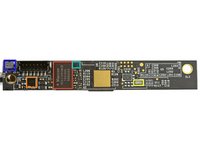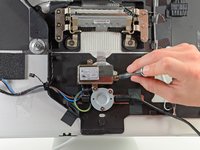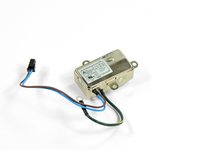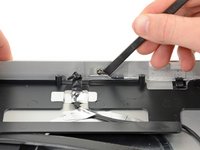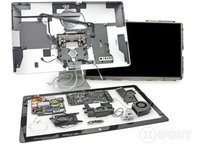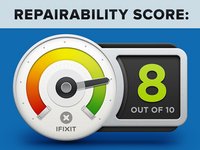Introduction
Crafted from the fire pits of Hephaestus himself, and thrust down to Earth by the mighty Zeus, the Apple Thunderbolt Display arrived at the doorstep of iFixit's headquarters.
Follow iFixit on twitter for the latest updates.
Cool bonus: Here's a wallpaper of one of Thunderbolt Display's chips, made in the Thunderbolt Display's native 2560 x 1440 resolution.
What you need
-
-
By the hammer of Thor! With the new Thunderbolt Display in our hands, the future is looking bright.
-
27" TFT Active-Matrix LCD
-
2560 by 1440 Pixel Resolution
-
Built-in Thunderbolt and MagSafe Cables
-
FaceTime HD Camera with Microphone
-
49 Watt 2.1 Speaker System
-
16:9 Widescreen Aspect Ratio
-
-
-
The Thunderbolt Display contains a sweet lineup of USB, HDMI, VGA, and DisplayPort ports! Oh wait—wrong thousand-dollar display.
-
The luscious backside of the Thunderbolt Display contains only a small line of specified ports:
-
Three powered USB 2.0 ports
-
FireWire 800 port
-
Thunderbolt port
-
Gigabit Ethernet port.
-
The Thunderbolt Display also comes with a built-in Thunderbolt cable attached to a Universal MagSafe cable.
-
-
Tool used on this step:Heavy-Duty Suction Cups (Pair)$14.95
-
Much like the iMac we tore apart earlier this year (and the iMacs before it), the Thunderbolt Display's front glass panel comes off with the help of some heavy duty suction cups.
-
-
-
The 27-inch (diagonal) TFT active-matrix LCD has a resolution of 2560 by 1440 pixels, the standard for displays of this size and price. Its 12 ms response time and 16.7 million colors, however, fall short of the 6 ms response time and 1.07 billion colors of Dell's comparable display.
-
We might be splitting hairs here, but those hairs would be viewed with 1,053,300,000 fewer colors on Apple's display. Just saying.
-
-
-
The back of the LCD display has only a few cables, none too exciting:
-
DisplayPort
-
LED backlight
-
LED backlight sync
-
Ground loop.
-
The LG display reads model number LM270WQ1. Is it possible that we may have seen this model number before?
-
Yes, it appears to be the same display found in the iMac Intel 27" from October of 2009, as well as the same basic LG display found in Dell's competing 27" monitor, though the Apple version uses LED backlights as opposed to Dell's traditional CCFL.
-
Dell's version is also matte, something that lots of Mac users have been harping for once the old 30" Cinema Display was phased out.
-
-
-
-
Stop—it's connector time! We remove a plethora (that's right, plethora, we're using our five dollar words) of connectors from the logic board, leaving only the brains behind the Thunderbolt port between us and the display's control center.
-
A few T6 Torx screws are knocked out to remove the connector cover, and the Thunderbolt cable is disconnected.
-
Interestingly enough, the Thunderbolt cable that routes into the display also plugs into a standard Thunderbolt socket on the logic board. Apple could have just soldered the cable wires to the board, but instead chose to implement a cover that prevents the cable from being detached from the logic board's Thunderbolt socket.
-
-
-
St. Damien's beard! The front of the logic board includes these stellar packages:
-
Pericom PI7C9X440SL PCIe-to-USB 2.0 host controller
-
L129NB11 EFL, which looks to be the Thunderbolt port controller (as viewed in the second picture)
-
Analog Devices ADAV4601 audio processor
-
NXP LPC2144 USB 2.0 microcontroller
-
Delta LFE9249 10/100/1000 Base-T LAN filter
-
SMSC USB2517-JZX USB 2.0 hub controller
-
LPC 1114F
-
-
-
Sweet grandmother's spatula! The back of the board also contains oodles of chips:
-
Maxim MAX9736B Mono/Stereo High-Power Class D Amplifier
-
Texas Instruments LC573A D-type Latch
-
Silego SLG8SP568VCK505 Clock Generator
-
LSI L-FW643E-2 Open Host Controller Interface
-
Broadcom BCM57761 Gigabit ethernet controller
-
Texas Instruments NH245 Dual Supply Translator
-
Supertex HV9982 3-channel switch-mode LED driver IC
-
-
-
Hot pot of coffee! Let's see what the Thunderbolt Display's power supply board can do for us.
-
How about 250 watts of maximum continuous power -- is that enough for you?
-
Fun science fact, the "thunderbolts" (AKA lightning) in nature can put out an average of 1,000,000,000,000 watts, that's 4 billion times the output of the Thunderbolt Display's power supply! But lets be fair...lightning bolts are much, much larger than this power supply and last only fractions of a second.
-
-
-
We see some fairly large speaker enclosures (well, for a monitor) near the side edges of the Thunderbolt Display and eagerly remove the screws holding them in place.
-
Wait! What have we here? Is that a built-in 1-inch subwoofer, as well?
-
Basically, your display will sound something like this. Okay, so maybe not, but you will get some pretty decent sound out of this bad boy.
-
-
-
The front side of the camera board:
-
cFeon LV010-45RNIP 11113A 1110ADA
-
The rear side of the camera board:
-
Vimicro VC0338BSMCB Camera Controller
-
Texas Instruments TPS65708 Power Management Unit
-
0BNHM7
-
408F N109
-
T120 Bd01
-
-
-
Thunderbolt Display Repairability Score: 8 out of 10 (10 is easiest to repair)
-
Only T6 and T10 torx screws hold it together, meaning minimal tooling is required to service.
-
Minimal use of adhesives means reassembly will be easier and cleaner.
-
Front glass panel and LCD are easy to remove and major components are exposed upon removal.
-
You have to use suction cups to remove the front glass, which could end poorly if not done properly.
-
While disassembly was very straightforward, there are a lot of parts, cables and connectors, making full reassembly not for the faint of heart.
-
36 Guide Comments
OMG, through hole components on the power supply board! And hand smeared silicon glue! How could 20 years of technology gap exist in a leading Apple product? Bob, that Flextronics board needs to come off. I'm not buying until then.
Every SPS is using the glue to pass the safety, you can choose not to buy anything with a SPS
Would you like to try developing a SMPS, which has to deal with hundreds of watts of current, using only surface mount components? Go on, give it a try. We will wait.
Question re: "Interestingly enough, the Thunderbolt cable that routes into the display also plugs into a standard Thunderbolt socket on the logic board."
Would it then be possible to install a 3rd party Thunderbolt "external" HD inside the monitor by simply connecting it to the socket on the logic board, then daisy chaining another thunderbolt cable to the external port? Is there enough space?
Ok, I know this comment is pretty old, but it looks like there's plenty of spaces to put a 2.5" drive but I doubt you could fit a 3.5" one.
Skylar -










